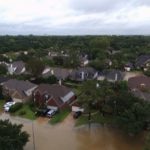What happens when your flood map is redrawn and your mortgage now requires flood insurance?
After Tropical Storm Allison drenched Houston and caused billions of dollars in damages in 2001, Harris County spent tens of millions of federal dollars to redraw its floodplain maps to more accurately reflect the risks. Now, 16 years later, after Hurricane Harvey left some homes flooded for the third time in as many years, those same maps are in the crosshairs.

Researchers from Rice University and Texas A&M-Galveston found that the Federal Emergency Management Agency’s 100-year floodplain maps failed to capture 75 percent of the damages from five major floods between 1999 and 2009. “What we’ve tried to show, both with this study and several others, is that it is possible to do better,” lead author Russell Blessing said in a press release on the study earlier this month. “There are innovative computational and hydrological tools available to build more predictive maps.”
These maps have far-reaching implications. They’re used to determine whether mortgages should require flood insurance, for one. So with momentum building for the floodplain maps to be redrawn, we talked to BBVA Compass Director of Investor Reporting and Mortgage Loan Servicing Scott Clark for his perspective on what to expect.
Do you have any indication of how long the flood-map redrawing process takes?
The flood maps will most likely take many months, if not years, before they're redrawn as there are many factors that need to align. Congress needs to provide the funding, for example, and FEMA needs to allocate its resources. Flood map revisions also have been influenced by other forces. For example, following Katrina, the residents of the 9th Ward were unable to fight any changes being made to their specific mapping, while more affluent neighborhoods were successful in countering the changes by hiring surveyors, lawyers and such. They were able to successfully argue that changes in the levies and pumps were sufficient to prevent them from being put in a flood zone, even though they were still below sea level.
The flood maps will most likely take many months, if not years, before they're redrawn as there are many factors that need to align.
Is there a universal threshold at which banks require flood insurance? Do they require it for homes in a 100-year floodplain but not 500-year ones?
Yes, mortgages on homes in a Special Flood Hazard Area are required by federal law to carry flood insurance. The SFHAs are defined as areas that have a 1 percent chance or more of being inundated by a flood event in any given year. It’s commonly referred to as the 100-year plain. Loans in the 500-year plain – where there is a 0.2 percent chance of flooding in any given year – are not required to have flood insurance.
Once the flood maps are redrawn in Houston, what is the process and how does that news get to the bank so it can start evaluating which of its existing mortgages may now need flood insurance?
Zone changes are tracked and communicated to us through a third party, our insurance tracking vendor. As those changes are made, the appropriate communications are then sent to the borrowers we have in those respective areas. Borrowers have prescribed periods of time to respond with proof of coverage, and if we do not receive proof within the time period, we will secure the proper coverage.
So the bank will proactively secure flood insurance in those cases where a mortgage-holder hasn't done so within the given timeframe?
Yes, absolutely. This is a federal requirement. We are mandated, by virtue of being a servicer of residential mortgages, to secure flood insurance for that mortgage.
We are mandated, by virtue of being a servicer of residential mortgages, to secure flood insurance for that mortgage.
What are a mortgage-holder's options once a lender tells them they're required to have flood insurance? How much time do they have to secure it? What are the penalties for not securing it within that timeframe?
This is typically established at the onset of the loan. However, if a loan were to fall into a higher-risk zone that requires flood insurance at a later time, as we anticipate will eventually come to pass after Harvey and possibly Irma, then those borrowers are notified by our insurance tracking agent. They are given 45 days' notice before the bank is required to secure coverage.